| Mar-17-08 | | Knight13: 7. h4 is weird. 20. Nd2 also. Reshevsky wanted White to provoke g4 and he just went right for it. |
|
| Mar-17-08 | | RookFile: My opinion is that Euwe had a strong grip on the position and Reshevsky did well to escape with a draw. |
|
| Mar-17-08 | | Knight13: Are you serious? I thought Euwe's the one who was suffering. Anyway, yeah, Reshevsky did well. Good counterattack. |
|
| Mar-18-08 | | Resignation Trap: Euwe missed his chance to win with 44.Re2?
Instead, 44.Nf6 Nf4 45.Ne4 should allow White to consolidate his position. |
|
Sep-11-23
 | | plang: Euwe had played 7 Bb3 against Keres in the 1st round; here he plays an innovation 7 h4!? aimed against Black's prospective ..Ng6 but it has not achieved much popularity. 19 g4?! led to weaknesses in White's position; 19 Bf4 or 19 Bd2 would have been better. 27..Rb8? was apparently an oversight; better would have been 27..Nxe3 though, in the game, Black did get some play for the pawn. 31 Rc2 would have been an improvement keeping pressure on f5 and thus not allowing ..Ne6. 35..Rb4? was a time pressure blunder leaving Black with a lost position. Perhaps a better defense would have been 36..Rxg4 37 fxg..Ne7 38 Nf6..Qd8 39 Rd3. White, however, allowed Black too much counterplay and after returning the piece with 44 Re2? had no real winning chances. A mistake filled but hard fought game. |
|
Nov-30-24
 | | KEG: By the time this 10th round game was played, Euwe was already having a disastrous tournament. These rounds (constituting the first two of five "laps" in the event) were all played in the Netherlands. Euwe might have been expecting to have a home-court edge here before the tournament shifted to Moscow for the final three laps (15 rounds). But instead of thriving in these early rounds, Euwe going into this final game played in Holland had only two draws (and five losses) in his seven games. So this game against Reshevsky was Euwe's final opportunity to get a win in his home country. Euwe unleashed a novelty as early as move seven, and a complicated game was the result. Reshevsky got into trouble both on the clock and on the board, and after some ups and downs he committed a blunder on move 35 that could have cost him the game. But Sammy was always at his best in some circumstances, and managed to set difficult problems for Euwe that--even after the adjournment where Reshevsky was piece down--Euwe failed to solve. It is unclear what went wrong for Euwe. In any case, he returned the piece on move 44, perhaps over-estimating the strength of his passed pawn. After some further tricky play, the game ended up as a draw. This draw left Reshevsky just barely ahead of Smyslov and Keres after the first two laps (eight games each) but still a point-and-a-half behind Botvinnik: Botvinnik---6.0
Reshevsky--4.5
Keres ---4.0
Smyslov --4.0
While Reshevsky must have been relieved to have avoided defeat here, with Botvinnik defeating Keres in this round, Sammy was now more than a point against Botvinnik--a gap he never closed and which only grew larger during the balance of the tournament. Missing a chance to pick up a full point against last-place Euwe here was part of the reason Reshevsky finished behind Smyslov and had to settle for a share of 3rd place with Keres. 1. e4 e4
2. Nf3 Nc6
3. Bb5 a6
4. Ba4 d6

click for larger viewThis form of Deferred Steinitz Defense got a work-out during the early rounds of this tournament. Keres played it in the 1st round against Euwe and got a slightly inferior game which he later nonetheless won. This result may have encouraged Reshevsky to try a similar line against Euwe here. In Round 8, Reshevsky played 4...d6 against Keres and drew a short but very sharp game. In the round after this one (i.e., after the scene shifted to Moscow), Reshevsky tried 4...d6 once again against Smyslov and was soundly beaten. As will be seen, Euwe had clearly anticipated that Reshevsky might try this line here and had prepared a surprise variation for the American: 5. c3
Keres had played 5. c4 against Reshevsky a few days earlier, but 5. c3 (and 5. 0-0) was a popular choice here, but Euwe had played 5. c3 in this opening round game against Keres, and Reshevsky himself played 5. c3 in the following round against Smyslov. 5... Nge7
5...Bd7 is more frequently played. Keres played that move against Keres in Round 1, but that game then transposed into the line employed here. While Horowitz called the text "awkward," Reshevsky played it again against Smylov in the next round. 6. d4 Bd7

click for larger viewIn Round 1, Euwe here played 7. Bb3, as did Smyslov against Reshevsky in the first round played in Moscow. But here is where Euwe sprung his surprise against Sammy: 7. h4
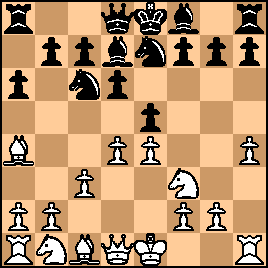
click for larger view"Weird"--(<Knight13>). "?!"--(<plang>)(Horowitz) As Euwe later explained, the text "was aimed against Ng6. But, as nearly all the commentators noted, the drawback of the text was the resulting weakening of the King-side. It was, however, "an interesting novelty" (Keres) that, among other things, helped get Sammy into time trouble. Whatever the theoretical merits of the move, the text helped make this game--warts and all--an engrossing one to play over and analyze. |
|
Dec-01-24
 | | KEG: Post II
7... h6
How to respond to Euwe's novelty?
As Keres pointed out in his commentary of this game, any notions of 7...Ng6 now are doubtful in light of 8. h5. Keres also questioned Panov's idea of 7...Nc8. Actually, that move looks like a reasonable option to me. It also avoided the weakness created by 7...h6. Keres claimed 7...Nc8 would be bad because of 8. BxN BxB 9. dxe5 Bxe4 since he thought 10. Ng5 would give White a strong attack. But this can't be right since Black now just plays 9... Bxg2 and after 10. Rg1 Bc6 11. e6 [Keres' idea] Black is fine and up a pawn after 11...fxe6 12. Nxe6 Qe7. Black still faces a troubling attack, but a pawn is a pawn. In this line, White has nothing better than an equalizing 10. Qe2. Keres thought Black's simplest was 7...exd4 8. cxd4 but now Black should play 8...Nc8 instead of Keres' 8...d5 which would be answered not by 9. e5 as Keres suggests [which allows Black to equalize with 9...Bg4] but rather either 9. Nc3 or 9. exd5, in either case yielding a small plus for White. After Reshevsky's actual 7...h6, the position was: 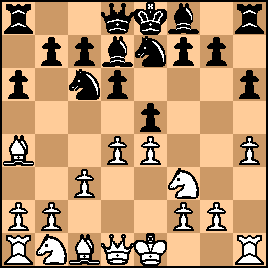
click for larger viewEuwe has succeeded to the extent of creating a position in which (after 7...h6 anyway) White has a small edge and for which Reshevsky had not prepared. But how to continue now? 8. Be3
Rightly called "premature" by Keres since the most efficient White set-up will depend on what transpires in the next few moves and since, as also pointed out by Keres [whose commentary should be the starting point for any consideration of this game] in some variations Black can gain time by attacking the Bishop on e3. Simplest [develop Knights before Bishops!] was 8. Nbd2. Another good choice was 8. Qe2, which has the advantage over 8. Nbd2 that in some lines the Knight is better developed on c3. 8... exd4
"Black finds it difficult to continue his development"--(Euwe) Golombeck criticized this move as needlessly surrendering the center. Both Golombek and Keres preferred 8...g6, but this would have created new weaknesses in the Black camp. The text appears to be a necessary evil (in giving up the center) but gives Black approximate equality. 9. exd4 d5
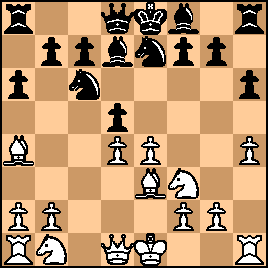
click for larger view10. e5
In line with Euwe's attacking zeal in this game. But it was still probably best to develop the b1 Knight first, either on c3 or d2. 10... b5
"...poor strategy; it opens the position while White has a lead in development"--(Horowitz) "This weakening queen-side advance was unnecessary, and is hardly positionally justified"-- (Keres) Horowitz and Keres both preferred the tempting 10...Nf5 [Keres also considers 10...Nc8 as an improvement on the text]. But neither consider or discuss what looks strongest for Black: 10...Bg4 (perhaps followed by Nf5. 11. Bc2
Probably more accurate than 11. Bb3 Na5 followed by 12...Nc4 or 12...Nf5 as per Keres. The text left:
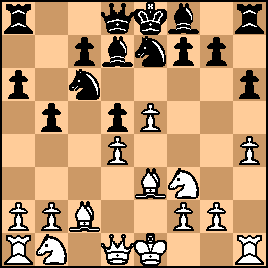
click for larger viewA complicated unbalanced position with lots of interesting play for both sides. Since both Euwe and Reshevsky were playing for a win in this last game before the scene shifted to Moscow, I suspect that both were pleased at how the game had unfolded to this point. |
|
Dec-02-24
 | | KEG: Post III
11... Na5
The commentators are over the map in trying to decide how Reshevsky (Black) should have proceeded here. Keres said that the text did nothing to "repair" his position, though he concedes that the possibility now of Nc4 for Black tended to discourage Nd2-b3-c5 by White. Euwe and Keres both contended that 11...Nb4 was bad after 12. Bb3, though Black could just retreat his Knight to b6 . Keres' alternative suggestion after 11...Nb4 of 12. Nbd2 seems to overlook that Black could then just play 12...Nf5 with all sorts of possibilities for both sides. Golombek's suggestion of 11...Nc8 hardly appears to be of much use to Black. The fact is that the position is very difficult, which is probably why the contestants chose to enter this thicket in search of a way to win. Stockfish and Fritz both opt for 11...Bg4, but that too yields an unclear position in which it is hard to tell who is better. The clock readings well it all:
Euwe: 0:54
Reshevsky: 1:12.
After only eleven moves, Reshevsky was already getting into trouble on the clock. Even after taking all this time, Horowitz could properly speak of Black's "laggard development." 12. Nc3 Bg4
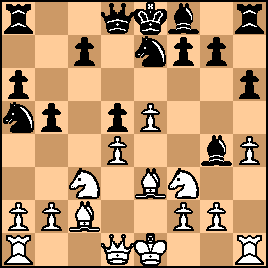
click for larger viewKeres claimed that the pin on f3 was "not particularly annoying for White" [Horowitz strongly disagreed with this assessment] and instead touted 12...Bf5. But then White seems to get the better game with little difficulty after 13. Ne2 eyeing f4, and if then 13...Bg4 White can just play 14. Nh2 and then, after the Black Bishop retreats, continue with 0-0 and Nf4. All in all, Reshevsky's move looks best to me.
13. a4
Horowitz liked Euwe's effort here to "break out on both wings." But the text would seem to allow Black to get good play with either 13...Nf5 or 13...b4. Euwe might have tried to forestall the latter possibility with 13. a3. Alternatively, he might just have focused on completing his own development with 13. 0-0 or maybe 13. Ne2 (daring Reshevsky to double his pawns with 13...BxN). 13... c6
Golombek called this "Unaccountably timid," claiming that Reshevsky could have obtained an "excellent game" with 13...b4. Horowitz claims that Black would then get a "terrific bind" on White's Queen-side. I too like 13...b4, though White is certainly then not worse after 14. Ne2 (as opposed to Horowitz' 14. Na2 which would allow Black to seize a strong initiative with 14...Nf5). The text left:
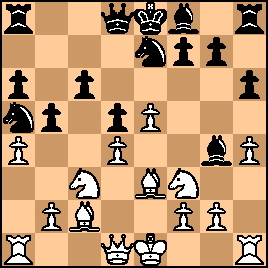
click for larger view14. Qd3
"To release the annoying pin." (Horowitz)
The extreme complexity of the position is again reflected by the different assessments of how White should proceed. Golombek [who disagreed with Horowitz and condemned the text as a waste of time and as permitting the exchange of the "Lopez Bishop"] and Euwe contended that White here should play 14. axb5, a move that hardly affords White any advantage. Keres likewise faulted allowing Black to force a trade of Bishops with 14...Bf5 and argued that "undoubtedly better" was 14. Ne2, a move that seems to allow Black to proceed easily with 14...Nf5. All of the suggested moves, like the text, have strengths and weaknesses and I see no basis to be dogmatic about the "best" approach for White here. From where I sit, both players made reasonable choices at this stage, and set the stage for the even greater complexities to follow. 14... Bf5
Quite right!
15. Qe2 b4
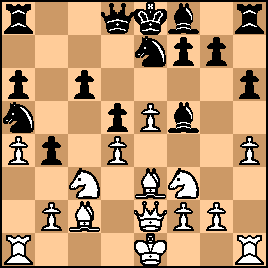
click for larger viewFritz and Stockfish, like the players, struggle to figure out who was better here. Among other things, it is hard to decide whether White here should immediately retreat with 16. Nd1 or whether he should initiate the Bishop swap. All this confirms my hunch that both players were pressing hard for a win and were thus willing to enter the difficult thicket they now entered. Not surprisingly, Reshevsky's time troubles soon grew even more serious (not that this ever seemed to discourage Sammy from playing difficult moves). |
|
Dec-03-24
 | | KEG: Post IV
16. Nd1
Euwe decided not to be the one to initiate the Bishop exchange. A reasonable but (in my view) close decision. 16... Qd7
Reshevsky likewise declined to exchange, increasing the tension. 17. Rc1
Horowitz called 17. b3 "an interesting maneuver." But then 17...Be4 looks good for Black since if then 18. BxB dxB 19. Nd2 Black then would have at least equal chances with either 17...Nf5 or 17...Qd5. In any case, the game is and would remain a close and complex struggle. 17... BxB
The trade now occurs.
18. QxB
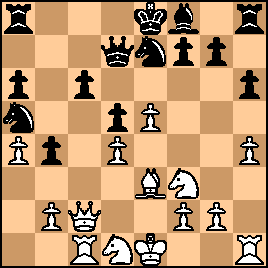
click for larger view"The players keep the position roughly balanced. White is exerting pressure on the c-file, but for the rest, his pieces are somewhat cluttered and scattered." (Euwe). This says it all. Matters would not have been very different had Euwe instead played 18. RxB. 18... Nf5?!
Golombek and Euwe preferred 18...Qf5. I tend to agree that this would likely have been marginally better than the text, but it would not have led to full equality for Black. Moreover, the line they give after 18...Qf5 hardly seems best: 19. QxQ NxQ 20. g4?! [This, like Euwe's actually 19th move, strikes me as premature, though my choice of 20. h5 is, in fact, only marginally better] 20...Ne7 [KEG--This can't be right. Black can and should equalize here with 20...NxB] 21. Nd2 [21. h5 is surely stronger] h5 22. f3 [KEG--and here, why not 22. g5]. Given the tenuousness of portions of this line, it is strange that Golombek and Euwe gave identical suggested moves. Did one of them crib the analysis of the other? Keres, by contrast, while recognizing the plus side of 18...Qf5 [but not giving the Golombek/Euwe line] and agreeing that 18...Qf5 would have assured Black of coiunterplay and approximate equality, opined that "After the text-move the White Queen turns out to be more active than Black's, and White obtains a slight advantage." I initially thought that 18...Qg4 was best, but after 19. Rh3 Nf5 [of course not 19...Qxg2?? 20. Rg3 and wins] 20. Nh2 NxB 21. NxN Qxd4 22. Nf3 things can get nasty for Black in many variations so over the board 18...Qg4 is probably not a great choice for Black. After 18...Nf5, the position was:
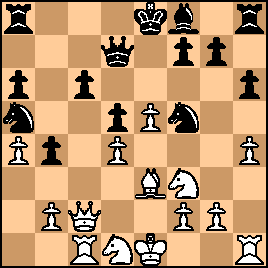
click for larger view19. g4?!
"?"--(Keres)
"?!?--(<plang>) Golombek, Keres, and <plang> all agree that the text creates serious weaknesses for White. Golombek claimed that this was a necessary evil since this was the only way White could continue the attack. Keres, however, felt otherwise: "This advance [19. g4] would only have been justified if Black would have been forced to play 19...NxB 20. NxN. However, after the simple Knight retreat [19...Ne7] the move 19. g4 just turns out to be a weakening of White's king-side and enables Black to...take control of the important f5 square." All true, but the text did augment the complexity of the position as a result of which, while Euwe got the worst of the struggle for a while, but then Reshevsky erred allowing Euwe back into the game, and eventually achieve what should probably have been a winning position. Put otherwise, the text may be theoretically awful, but over the board led to a wild struggle in which Euwe might just have come out on top. Whatever its dubious merits, 19. g4 made this game into the absorbing battle that had me transfixed with this game for the better part of two weeks. In other words, I am delighted that Euwe chose to play it. I should mention that Euwe could more simply have obtained a theoretical edge with the more stolid and safe 19. Bd2 touted by Keres and <plang>. They also recommend 19. Bf4, which likewise yields some edge to White. After Euwe's actual 19. g4, the position was:
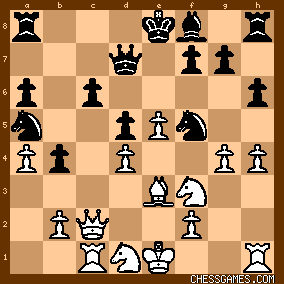
click for larger view |
|
Dec-04-24
 | | KEG: Post V
19... Ne7
"!"--(Keres)
"Not wishing to help White by 19...NxB 20. NxN h5 [This only makes matters worse for Black. Better, but not achieving anything like equality, would be 20...Be7 or the more combative 20...0-0-0--KEG] 21. Ng5 Be7? [Black here might as well try 21...0-0-0--KEG] 22. e6! [White can probably also win with 22. gxh5--KEG]"--(Golombek) In fact, the only way for Black to meet Euwe's hyper-aggressive 19. g4? was with Reshevsky's excellent 19...Ne7, which left: 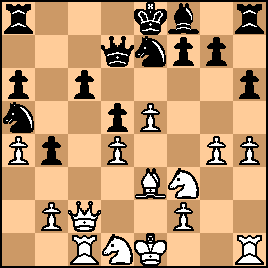
click for larger view20. Nd2
"Weird"--(<Knight 13>) "!"--(Horowitz)
There is indeed a major difference of opinion about this move! Perhaps the best overall assessment of Euwe's move is: "White tries to complicate the position at any cost"--(Keres) Probably the only way for White to keep his head above water after 19. g4?! was with 20. Rg1. Keres claimed that after 20. Rg1 Black would get a good game with 20...h5. But then White just plays 21. gxh5 Rxh5 22. Bg5 with much the better chances. In fact, best for Black after 20. Rg1 would be 20...c5! with a wild game that would have been fun to witness. Returning to the actual game, the position after 20. Nd2 was: 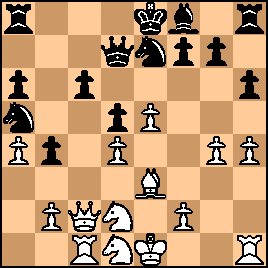
click for larger view20... Qxg4
Golombek, Horowitz, and Euwe all claimed that 20...h5 was far stronger. But then White equalizes with 21. g5 (rather than Golombek's suggested 21. Bg5 after which Black would indeed have the upper hand. As will be seen, the text was quite strong (as was 20...c5, which nobody seems to have discussed). Keres hedged his view here, saying that 20...h5 was "worthy of consideration" but that the text was "fully satisfactory for Black." I would go one step further and say that Reshevsky's move was simplest and best and created an immediate crisis for White. After 20...Qxg4, time trouble for Reshevsky further raised its ugly head: Euwe: 1:25
Reshevsky: 1:55
21. Qc5
Euwe might equally well have tried 21. f3, in either case leaving himself in difficult straits. Now, Reshevsky had to make a tough decision:
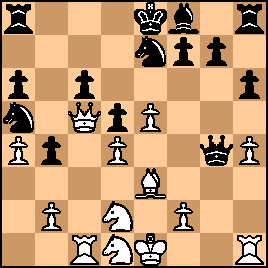
click for larger view21... Nb7
21...Qg2 was another good choice for Black.
22. Qxb4
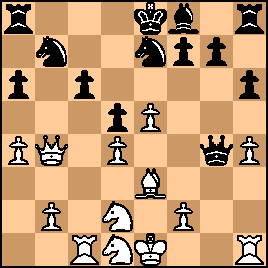
click for larger view22... Nd8!
"A typical Reshevsky position; he hangs on by the skin of his teeth, but he hangs on"--(Horowitz) Actually, I much prefer Reshevsky's position at this point. Keres claimed that 22...Qg2 was superior to the text, but he only considered 23. Rf1 and ignored the wilder (and better!) 23. Qxb7! Qxh1+ 24. Ke2 Rc8 25. Nf3 Qh3 26. Qxa6 leaving White with a pawn for the lost exchange the decent counter-play, surely better than what he got in the actual game. 23. f3
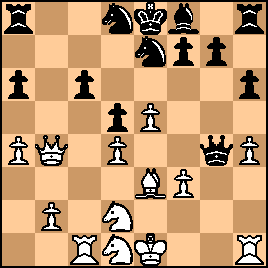
click for larger view |
|
Dec-05-24
 | | KEG: Post VI
23... Qg2
Most of the commentators (Golombek, Horowitz, and Keres) concluded that the immediate retreat 23...Qd7 was best. Ultimately, as Keres noted. The text "turns out to be a loss of time, and enables White to win valuable time for his defense." While I tend to agree, let's see what Reshevsky had up his sleeve as a possible explanation for his temerity in playing the text. 24. Rg1
Pretty much forced.
24... Qh3
24...Qh2 may have been a better way to try to hold onto Black's edge. But let's withhold judgment until we see where Reshevsky is going with all of this. 25. Bf2
Golombek aptly pointed out that an attempt to box out White's Rook with 25. Rg4 would lose: 25...Nf5 26. Qc3 NxB [KEG--this is Golombek's suggestion that perhaps wins for Black. But the nastiness and most powerful effort for Black would be 26...Ng3 27. QxN and now 27...Be7 rather than Golombek's 27...Bb4?? which flips the edge to White after 28. Nf2 Qh2 29. Ke2! [a pretty quiet move--KEG] BxN 30. QxN with a still fiendishly complicated game. 25... Qc8
"?"--(Golombek)
All of the commentators contend that 25...Qd7 would have been better, but I see little to choose between the two moves, both of which still yield somewhat better chances for Black. But play on the king-side such as 25...h5 or 25...g6 or maybe 25...Ng6 may have been best. But, at the risk of repeating myself, let's see what Reshevsky was cooking up. 26. Qc3
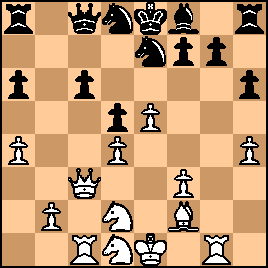
click for larger view26... Nf5
Objectively, 26...Rb8 or 26...h5 (or maybe 26...a5) may be superior. But, as we will see from Reshevsky's next move, he was preparing to blow up the position. 27. Ne3

click for larger view27... Rb8?!
"?"--(Golombek)(Euwe)(Keres)
As the above three commentators stated, joined by <plang>, the text drops a pawn while Black retains some edge with 27...NxN. Horowitz stated that "It is difficult to judge whether Black's last is an oversight or a miscalculation." And indeed Reshevsky was in time trouble. But was 27...Rb8 really such an awful move? As Keres was forced to admit just a few moves later, Reshevsky "gained a couple of tempos for his development in return for the pawn" and generated attacking chances. It must be recalled that Euwe was playing horribly in this tournament. Maybe Reshevsky, even as his time dripped away on the clock, saw a way to throw Euwe off balance. One thing seems certain, the text didn't put Reshevsky in anything close to a losing position. 28. Nxd5
I am loath to believe that Reshevsky didn't see this resource. 28... Qd7
As Keres correctly recognized, 28...Qb7 would not have saved the pawn for Black and would only have made matters worse for him: 29. Ne3 NxN 30. QxN Qxb2 31. Rb1 winning the Black Queen. 29. Nf4 Bb4
Winning the tempo noted by Keres.
30. Qd3 0-0
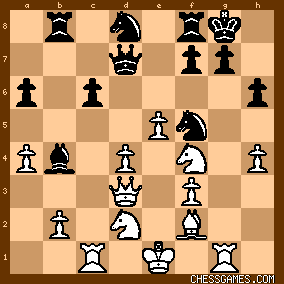
click for larger viewHere, with the clock ticking down for both players, the critical chapter of the game was about to begin. Yes, Euwe had an extra pawn. But, over the board, finding the strongest continuation was not easy, and as I will discuss in my next post on this game, Euwe failed to find the best 31st move, instantly giving Reshevsky the chances he sought. Fasten your seat-belts! |
|
Dec-06-24
 | | KEG: Post VII
31. Kf1
"?"--(Keres)
The Commentators are nearly unanimous in their preference for the far stronger 31. Rc2: "After this inaccuracy Black gets the chance to make up for his mistake [sic--KEG], and again obtains an excellent position [KEG--More accurately, a complex position with approximately even chances]. White had to prevent Ne6 at any cost for as long as possible. Therefore the defensive move 31. Rc2 had to be played"--(Keres) After the text, Black can easily prevent Ne6 by Black, as Reshevsky quickly demonstrated, the position now being: 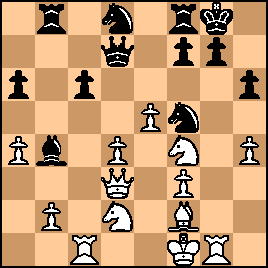
click for larger view31... BxN!
"Or else White plays Ne4 with the terrible threat of Nf6+"--(Golombek) "It goes without saying that Black will not allow this Knight to come to e4"--(Euwe) Perhaps even more significantly, Reshevsky's move made it possible for him to play the freeing Ne6 on his next turn. Euwe: 2:07
Reshevsky: 2:20
32. QxB Ne6
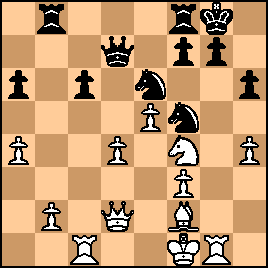
click for larger view"With his excellent Knights pressing on White's centre with dangerous threats, Black again stands well. White must be lucky if he is to escape with equality from this position"--(Keres) A bit of an overstatement by Keres. White IS still a pawn ahead and still has threats on the King-side. For whatever it's worth, Fritz rates the game as (0.00) while Stockfish rates it as (-0.52). Speaking for myself, I would prefer to be playing Black at this juncture, but not with the minimal time (10 minutes) Reshevsky had to make his next eight (8) moves. Horowitz, however, had a very different assessment: "By the Pawn loss Black has succeeded in castling and working up a measure of counter-play. This, however, is insufficient." To the extent there is no abstract "truth" to be ascertained in this position, I reckon it lies somewhere between the polar opposite evaluations of Keres and Horowitz. 33. Nh5
"Now the other Knight takes over the threat [i.e., Nf6+]"--(Golombek) 33... Kh8
34. Rg4
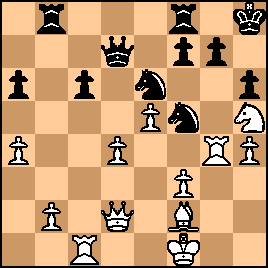
click for larger viewHow should Reshevsky proceed here?
34... Rb3
"?"--(Keres)
Nobody much likes this move:
"A superficial penetration which involves a loss of time"--(Horowitz) "With the text move, Black forces his opponent to bring his last piece into the battle...and in that way he only makes White's defense simpler"--(Keres) Horowitz suggested 34...Rb7, which is not bad but then White could consolidate and continue to proceed on the Queen-side with 35. b4 or 35. Qc3. Keres' idea of 34...Qd5 looks better, He gives the following line: 35. Qd3 g6 [Forced--KEG] 36. Nf6 Qa2! "...and Black at least wins the pawn back." (Keres) In addition to Keres' suggestion, other good choices for Black include 34...a5; 34...c5; and 34...Rb7. In fairness to Reshevsky, his move (played with little time remaining on his clock for reflection) was (Keres notwithstanding) not a terrible move and still left him very much in the hunt. 35. Rc3
Obviously best:
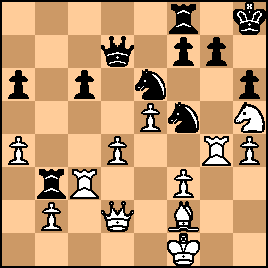
click for larger viewIn this fiendishly difficult position, Reshevsky succumbed to his time trouble and blundered away a piece. Needless to say, this should have allowed Euwe to chalk up his first win of the tournament. But, as will be seen, the position remained extremely tricky, and Reshevsky was able (even as his time ran out) to create problems for Euwe that the former champion was unable to solve, allowing his opponent to escape with a draw. |
|
Dec-07-24
 | | KEG: Post VIII
35... Rb4?
"?"--(Golombek)(Euwe)(Keres)(<plang>) "...loses material"--(Golombek)
"Another [sic--KEG] tactical error..."(Horowitz) "A blunder in time trouble that suddenly places Black in a lost position"--(Keres) "A time pressure blunder leaving Black with a lost position"--(<plang>) This loses a piece and should have lost the game for Reshevsky. The refutation is subtle, but Euwe spotted it. Time pressure undoubtedly explains this lapse by Sammy, which left, As most of the commentators pointed out, Black should be fine with 35...Rfb8. But both Golembek and Keres mistakenly suggest White should then play 36. Qc2 which in fact would have been a mistake giving Black a chance to win a pawn (albeit probably not enough to win), i.e., 36. Qc2 Nexd4 37. RxR RxR 38. BxN Rxf3+ 39. Ke2 QxB! [the commentators probably missed this cute combo-KEG] 40. KxR QxR+! 41. KxQ Nc3+ [the hidden resource] 42. Nf4 NxQ leaving Black up a pawn in the Knight and pawn ending which White probably could still draw given the aggressive position of his King. After 35...Rfb8, White should simply play 36. Qd3 RxR 37. bxR g6 38 Bf6 Qb7 after which Black's attack probably balances out his pawn minus. Other saving moves for Black here were 35...Rb7; 35...Qb7; and 35...RxR 36. bxR Qb7. Horowitz suggested 35...Qd5, but White then (even if not quite winning) would be in the ascendant after 36. Qd3 RxR 37. bxR g6 38. c4. In any case, after Reshevsky's error on move 35, the position was: 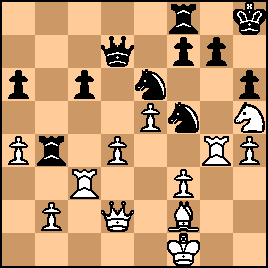
click for larger viewActually, and in fairness to Reshevsky, there is only one move that wins for White here. Unfortunately for him, Euwe--though also low on time--found the winning move: 36. d5!
"!"--(Golombek)(Horowitz) Euwe)(Keres)
"Again the fatal d5-square"--(Euwe)
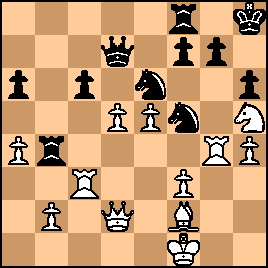
click for larger view36... a5?!
"?"--(Horowitz)
"Black's position is lost, so he hopes to stir up some complications with a piece sacrifice"--(Keres) Many commentators (including <plang>) suggested 36...RxR. But that would hardly have saved the day for Black: 36...RxR 37. fxR Ne7 38. Nf6 [38. d6 suggested by Euwe as another way for White to win would in fact have blown the win after 38...Ng6 (rather than Euwe's 38...Nd5)] Qd8 and now not 39. Rd3 as given by Euwe and <plang> which would actually leave Black on top after 39...cxf5 40 . Nxd5 NxN 41. RxN Qa8! and suddenly White is in trouble, but 39. Qd3+ [threatening mate] gxN 40. dxN QxQ+ 41. RxQ fxe6 42. Rd6! after which Black's pawns get decimated. As a practical even if not theoretical matter, Reshevsky's 36...a5 was surely his best--and perhaps only--chance to save the game. It left: 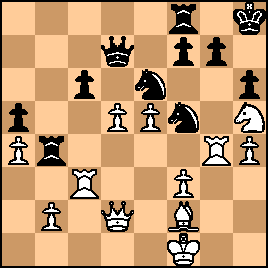
click for larger viewThe position is still very difficult--especially with time running out on the clock. Indeed, none of the commentators found the strongest winning line for White here as I will discuss in my next post on this game. |
|
Dec-07-24
 | | KEG: Post IX
37. Qd3
This wins a piece and theoretically wins the game: "By unpinning his Queen and attacking another Knight at the same time, White forces the win of a piece and therefore, one would think, the game"--(Golombek) "White's Queen is now defended and two of Black's men are attacked simultaneously"--(Horowitz) "After the text move both Knights are attacked, which means that the sacrifice that now follows is forced"--(Euwe) "White attacks both Knights and, in addition to this, after the retreat of the e6-Knight, threatens to play 38. Bc5. Hence Black's subsequent piece sacrifice is practically forced"--(Keres) But while the text should theoretically win, the position remains highly difficult and--as we know--Reshevsky now eventually managed to save the game. So the search was on to find another line for White here. Most of the commentators considered 37. RxR, but that is less convincing than Euwe's actual move: 37...axR 38. Rxc6 Rd8 39. Rd6 may well allow Black to escape: 39...NxR 40. dxN Qxe6 41. exN Qh3+ [much better than 41...Rxd6 as given by some commentators] 42. Kg1 Qxf3 43. Ng3 Qf6 after which, at best, White would have had a rough road to try to find a way to win. Remarkably, no one seems to have found the completely crushing live for White here: 37. Rxc6 after which White wins in a walk: 37...RxR 38. fxR Nfd4 [or 38...Ned4 39. Rc3 Qxd5 40. fxN Qh1_ 41. Bg1 leaving White a piece and a Pawn to the good with a still undiminished attack] 39. Rd6 Qxa4 40. BxN NxB 41, Nxg7! Qb3 42. Rxh6+ Kg8 43. QxN wins since 43...KxN runs into 44. Rf6 and Black is dead. But let us return to Euwe's actual move: 37. Qd3 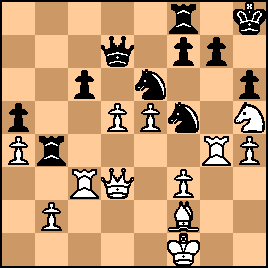
click for larger view37... Qxd5
As Horowitz pointed out, 37...Nd8 gets crushed by 38. Bc5. The other alternative, 37...Nc7, likewise doesn't work out well for Black: 38. Bc5 [ouch] Nxd5 39. BxR(f8) Nfe3+ 40. Ke1 NxR 41. fxN Rxg4 42. Bxg7+ RxB [forced] 43. NxR KxN 44. Qd4 and White should win this exchange up ending. 38. QxB Rxb2
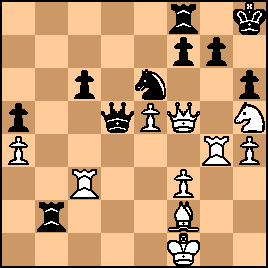
click for larger view"Despite the extra piece, White must still be careful"--(Horowitz) Subsequent events demonstrated the wisdom of this remark. Euwe: 2:15
Reshevsky: 2:20
Indeed, the position is still very difficult. Remarkably, and even with all the time in the world to study the position (unlike what actually was going on where both players were under severe time pressure at a time when there were no increments) only Keres found the winning move for White here. 39. Rd3
"?"--(Keres)
Golombek here proposed 39. Rgc4 as a "safer line of play." But this probably blows the win: 39...Qd1+ [much better than Golombeck's 39...g6] 40. Kg2 g6 41. Qf6+ Kg8 42. Nf4 Rb1! after which Black draws: 43. g3 Qh1! 44. Nxg6 [the only possible winning try here for White] Rg1! 45. BxR QxB+ 46. Kh3 fxN 47. QxN+ Kh8 48. Rxc6 Qh1+ 49. Kg3 Qg1+ and draws by perpetual check. The clear winning move here for White--discovered by Keres--is 39. Be1!! , e.g., 39...g6 40. Qf6+ Kh7 41. Nf4 NxN 42. QxN Rb4 43. Qd2 Qxe5 [or 43...QxQ 44. BxQ Rd8 45. Ke2 with a winning piece up endgame] 44, RxR axR 45. Rxc6 with a piece up winning engame. After Euwe's actual 39. Rd3, the position was:
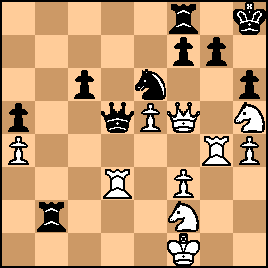
click for larger view39... Qa2
Forced
40. Be1
Forced.
40... Rh2
Forced:
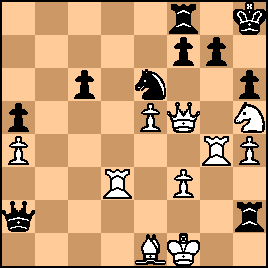
click for larger viewHere the game was adjourned and Euwe (White) sealed his move. As all of the commentators recognized, this adjourned position is still very difficult and very sharp. |
|
Dec-08-24
 | | KEG: Post X
41. Re3
"The sealed move which indeed should win"--(Golombek) "Black's various threats make it difficult for White to make use of his material advantage"--(Keres) While Keres says that Euwe's sealed move is "apparently sufficient for a win," he thought that a better way was with 41. Kg1. I'm not sure this is quite right. After 41. Kg1, Horowitz--in my view--correctly recommended 41...Re2 after which the win suddenly seems elusive: 42. Rd1 Qb3! 43. Rb1 [not 43. Rxg7 Qe3+ 44. Kf1 NxR 45. Qf6 Rg8 46. NxN RxB+ 47. RxR Qd3+ 48. Kf2 Qd2+ 49. Re2 Qd4+ 50. Re3 RxN 51. Qxh6+ Kg8 and draws] Qe3+ 44. Kf1 Rh2 45. Ng3 and now 45...Nd4 46. Qe4 Nc2 47. Rb2 Qc5 48. RxN RxR after which Black's Rook and pawn for White's two minor pieces may be able to hold the draw. The real question is whether White can win after Euwe's sealed move, the position now being: 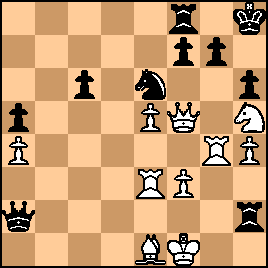
click for larger view41... Rh1+
As most of the commentators pointed out, White wins after 41...Nd4 42. Qe4 Rh1+ 43. Rg1 Qh2 44. Qg4. 42. Rg1
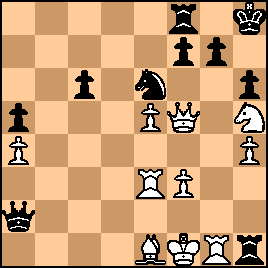
click for larger view42... Qh2?
Although not mentioned in any commentary I have seen, this looks to be a mistake easing White's task. Black's best chance lay in 42...Rh2 43. Qe4 Rd8 44. Qxc6 g6 45. Nf6 Kg7 46. h5 Rd1 47. Ng4 Rxh5 after which White's win, even if still there, is highly difficult. But now, the win for White seems clear:
43. Qg4!
Not 43. Bf2? g6 and now it is White who would need to scramble to achieve a draw. 43... g6
43...Rd8 might have offered more onerous resistance. After the text, the position was: 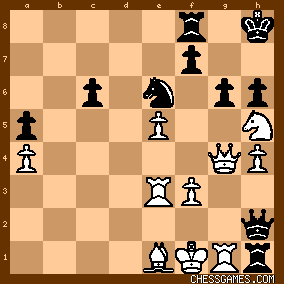
click for larger view"Now a critical position has again occurred. The question now is whether White can play 44. Nf6 and allow Black the change to strengthen his attack by 44...Nf4. Answering this question is by no means simple, and the occurring variations are so complicated that Euwe did not risk choosing them even after a long home analysis"--(Keres) In fact, 44. Nf6 is the only move to win here for White: 44...Nf4 45. Ne4 and now Black has no escape: (A) 45...Nh3 46. RxR QxR+ 47. Ke2 Qh2+ 48. Nf2 and White wins; (B) 45...h5 46. RxR QxR+ 47. Qg1 (forced) Qh3+ 48. Kf2 and Black has no way to continue the attack or save the game; (C) 45...Nd5 46. Re2 RxR+ 47. QxR 47. Qh3+ 48. Kf2 Qxh4+ 49. Qg3 and White should win; (D) 45...Rb8 46. Nf2 RxR+ 47. QxR Qxh4 48. Qg4. Of course, all this requires time (and is much simplified if computers are consulted). So perhaps we shouldn't be too harsh on Euwe and must congratulate Reshevsky on his resourcefulness in saving what looked like a lost game. In any case, here Euwe played:
44. Re2?
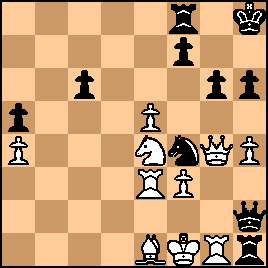
click for larger viewIt is impossible to tell whether Euwe overlooked that this allows Black to regain the lost piece or whether he mistakingly believed he could still win the resulting endgame. In any case, as I will discuss in my next post on this game, after the text Reshevsky alertly managed to draw, albeit not without some remaining difficult moments before the game ended. |
|
Dec-08-24
 | | KEG: Post XI
Oops!
I gave the wrong position after 44. Re2. The correct position is: 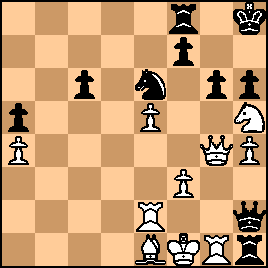
click for larger viewMy apologies to anyone I misled.
So now let's look at the actual position after Euwe's blunder on move 44. Is it really as simple as it looks for Black; just trade twice on g1 and then grab? Yep:
44... RxR+
45. QxR QxQ+
46. KxQ gxN
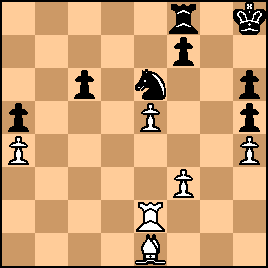
click for larger viewIf indeed Euwe allowed this position on the assumption that White can still win, he was plainly and seriously mistaken: "White still has a slight endgame advantage, but against Reshevsky's flawless defense this proves impossible to convert"--(Euwe) Whatever it was that went wrong for Euwe, the game was now a draw and Euwe lost his final chance to win a game before the home-crowd fans before the scene shifted to Moscow, although there were still a few moments of interest before the players formally agreed to a draw: 47. Re4 Kh7
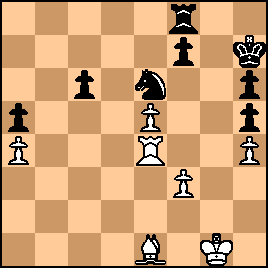
click for larger viewBoth Golombek and Keres claimed that the text was an easier way to draw than defending the a-pawn with 47...Ra8. I certainly understand the reluctance to use the Rook as a defender rather than keeping it in more active play, but in this case 47...Ra8 may well have been the more economical way to play to half the point. After 47...Ra8, both Golombek and Keres recommend 48. f4 (followed by 49. f5 according to Golombek). But then Black just plays 48...Rg8+ followed by 49...Nc5. In fact, it was the text move (47...Kh7) that gave Euwe some (tiny) chances: 48. Bxa5
48. Rc4 might have given Euwe more practical chances. 48... Rb8
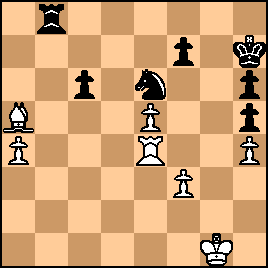
click for larger viewAs noted above, activating the Rook seems like excellent general strategy in such endgames. But now Euwe might have made the draw more difficult for Reshevsky with 49. Bc3 (with a view to a later a5). I therefore prefer the simple and--in my view--clearly drawing 48...Ra8. However, as will be seen, Euwe seems now to have been psychologically spent (here and on move 54) and made little effort to press for some way to win. I would bet that Bobby Fischer or Magnus Carlsen would have tortured Black for a very long time after 48...Rb8. 49. Rb4
Not a very dynamic move. But Euwe may have been downcast after failing to convert a piece-plus endgame. 49... Ra8
Now the draw looks simple for Black:
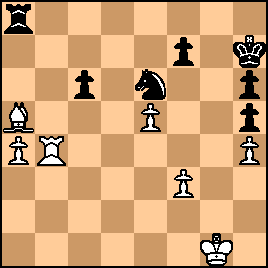
click for larger view50. Bb6
Obviously forced.
50... Kg6
The King is a fighting piece in the endgame.
51. a5 Kf5
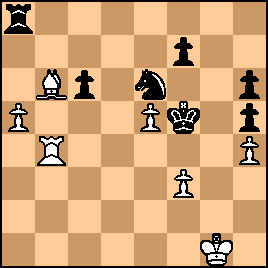
click for larger view"Thus it becomes evident that Euwe has over-rated the efficacy of his passed Pawn"--(Horowitz) Euwe: 3:21
Reshevsky 3:05
To augment what must have been Euwe's gloom, he was now actually behind on the clock. The game was now a clear draw. But as will be seen Reshevsky, understandably wanting to exploit Euwe's distress, began to press for a win for Black and, had Euwe been his old self, might have gotten into trouble before he was able to collect the half-point. |
|
Dec-09-24
 | | KEG: Post XII
52. Re4
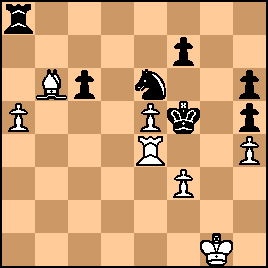
click for larger viewThe position requires some care by Black to avoid trouble. As Golombek pointed out, 52...Nf4 could be dangerous for Black, though Golombek's analysis had several holes: White should indeed play 53. Rc4 putting Black under serious pressure. Black's best chance would then be 53...Ng6 54. Rxc6 Nxe5 55. Rc5 Ke6 56. Kg2 after which Black will have to fight hard to try to draw. But Golombek's line here was bonkers: 53. Rc4 Kxe5? This is a gross blunder and Black should lose on the spot because of 54. Bc7+ winning the Black Knight. Golombek's 54. Rxc6 may also win, but now matters are not so clear. But the situation would be entirely cleared up if Black played Golombek's 54...Ng6 [54...Ne6 would at least give him a fighting chance] Now, White can win with the seemingly obvious 55. Rc5+which tears Black to pieces. But Golombek gave 55. a6 as correct. Now Black pretty much has to play 55...Nxh4. But Golombek's line had instead 55...Kd5? after which White wins fairly easily [Golombek got this part right] with 56. Rc5+ and then 57. a7 Not Golombek's best work.
But now returning to the diagrammed position, what should Black play. 52... Ra6
The best way to draw here for Black was 52...c5 (making use of his own passed pawn). I'm not sure what Reshevsky was up to with 52...Ra6, but things soon got dicey for him. I should note that at this point the commentators appeared to lose interest in the balance of the game. In fact, Black is holding on by his fingertips: 53. Kf2 Nf4
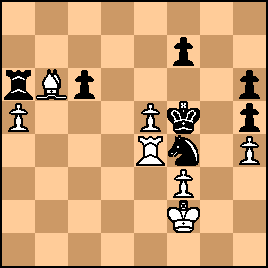
click for larger viewNow White can turn up the heat with 54. Kg3! Nd5 55. Rc4 [targeting the Black c-pawn] NxB 56. Rxc6 Rxa5 57. RxN Kxe5 58. Rxh6 Kd4 59. Kf4. This with best play is still a draw, but Black might have to sweat a bit. Euwe's move, by contrast, gives Black no real problems at all if he finds the correct response: 54. Rc4 c5!
Alert as ever, Sammy found what may have been the only saving move. Obviously White can't play 55. Rxc5?? which would run into a Knight fork (55...Nd3+) 55. Kg3
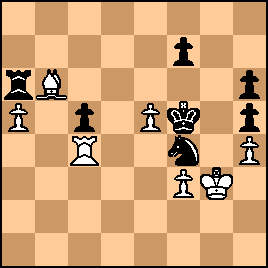
click for larger viewNow Black has an easy draw with 55...Ne2+. But... 55... Nd5
"After which the defender of the dangerous pawn is removed"--(Horowitz) 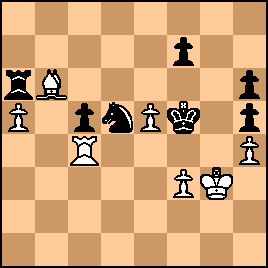
click for larger viewYes, the game is now a draw. But shouldn't Euwe have made Reshevsky work hard to get the half-point with 56. Rxc5 NxB 57. Rc6 [the pin again] Rxa5 58. RxN Kxe5 59. Rxh6 Kd4 60. Rf6 Ke5 61. Rxf7. Yes, this is a theoretical draw [ask any computer!]. But White has an extra pawn and can torture Black for a while. In any case, Euwe made no real effort here:
56. Bd8 Ra8
57. Bb6
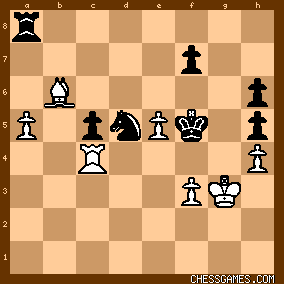
click for larger view1/2 -- 1/2 |
|
|
|
|





